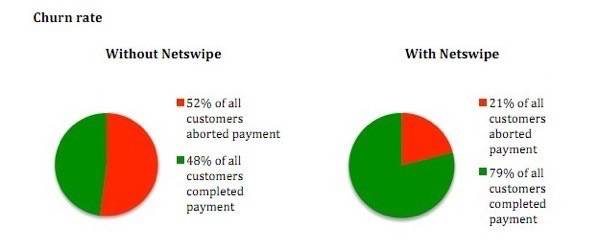Payments company Jumio is today launching a new technology called Netswipe that turns any webcam into a credit card reader, both on the desktop and on mobile. The service aims to bridge the convenience of online and mobile shopping with the security inherent in face-to-face transactions. It also makes it incredibly easy to shop you just hold up your credit card in front of your webcam to complete the transaction.

Fighting Online Fraud with a Webcam
Credit card fraud is a big problem, explains Jumio founder and CEO Daniel Mattes, “it’s 200 hundred billion per year in the U.S. alone,” he says. Yes, that’s per year.
When conducting business online, the fraud risk is even greater because merchants are dealing with “card not present” transactions – meaning transactions where a physical card has not been swiped in a reader. When merchants process these fraudulent transactions, they end up dealing with chargebacks and lost revenue.
For consumers, the processes the merchants put in place to help prevent online purchase fraud are often a hassle – creating a username and password on the site, filling out long forms filled with personal information, and entering in the CVV code from the back of the card. The frustration of this lenghty process can lead to lost sales. Jumio says that Netswipe can help here too. It conducted a focus group study which found that customers using its solution were more likely to complete their online transactions (79% with Netswipe vs. 48% without).

But Jumio doesn’t want to just improve churn rates for merchants, it aims to disrupt the entire payments system by providing a seamless, one-stop solution for both merchants and developers alike.
The Technology
Using computer vision technology, the software analyzes five frames of the webcam’s video stream to “see” the credit card. It does not take a picture or store the card information on your computer. The process of reading the card is brief – only 250 milleseconds. Jumio’s technology then verifies and processes the transaction.

The computer vision technology is highly accurate, too. Only 1 out of 1 million transactions are misread, thanks to the advanced system used behind the scenes. Over the course of a year and a half, Jumio seeded its network with data samples in order to train it. Now, the entire system is fully automated. The company’s staff uses a 24/7 monitoring tool to track potential fraud, but are not involved in the actual transactions. It’s the software that knows if you’re holding up a real credit card or a piece of paper.
On Mobile: An App for Merchants, A Library for Developers

But the solution Jumio designed is not intended only for online shopping. There’s a two-part mobile platform, too, launching later this year.
Mobile App
The first part will be a cashier solution, similar to Square, the popular dongle that attaches to an iPhone or Android, allowing individuals and small business owners to accept swiped transactions. Like Square, there will also be a mobile application, just no dongle. Instead, customers will hold up their credit card in front of the phone’s camera.
Developer Library
A second part to the mobile solution is a library that will allow developers the ability to integrate Netswipe technology into their mobile applications. This piece of Jumio’s solution is the one that’s most similar to Card.io, which offers SDKs for mobile developers.
The big difference between what Card.io provides and Netswipe is that Card.io still requires that developers use their own merchant accounts – it only does the computer vision portion. Essentially, it’s an easier way to fill in the forms.
Although Card.io may add merchant partners in the future, it does not yet offer those today. Meanwhile, Jumio is providing the complete solution – not just the scanning interface, but the authorization, processing and fraud prevention. “The advantage for mobile developers,” says Mattes, “is that mobile apps don’t have be PCI-certified.” (Payment Card Industry Security Standard, required for any business that processes credit card transactions.) Instead, developers simply add Jumio’s library to their app in order to start taking payments. And it can work alongside other solutions, too.
As Cheap as Square
The cost of using Jumio’s system is affordable – just 2.75% per swipe for small and micro transactions, the same as Square. Also like Square, there are no other hidden fees or monthly charges. However, for larger organizations, the rate may be higher. Mattes says it will vary between merchant types and country.
Facebook Co-Founder Eduardo Saverin is Lead Investor
Jumio’s core team, including its CEO, comes from the Internet telephony startup Jaja. It also has an impressive list of investors, including Facebook co-founder Eduardo Saverin, who’s a member of Jumio’s board and who previously led a Series A funding round of $6.5 Million. The advisory board also includes Zain Khan, a former Google exec, Mark Britto, former Amazon executive, Thomas Jungreithmeir, managing director of TJP and Bjorn Evers, a former gaming industry CEO.
More info is available now on Jumio.com.

















